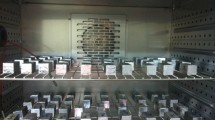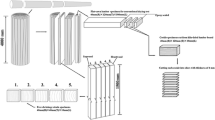Abstract
This study was conducted to develop analytical models for the prediction of drying stresses and defomations in lumber. Both one- and two-dimensional analytical models were developed with two assumptions: the visco-elastic creep could be neglected, and the diffusion coefficient is constant with moisture changes. The method developed in this study showed that the drying stress of lumber with symmetric moisture profile could be approximately predicted using one-dimensional (1D) and two-dimensional (2D) models. In the case of the 1D model, drying deformations could be determined rather easy and the drying stress can even be predicted by hand calculation. The results of this study might be used for lumber with an asymmetric moisture profile. In order to predict more accurately drying stress and deformation across overall moisture changes, however, this procedure should be incorporated with the other moisture transport models and might be extended to a 3D model.






Similar content being viewed by others

Abbreviations
- u, v:
-
displacement in width and thickness directions, respectively
- E :
-
Young’s modulus
- σ :
-
stress
- ε :
-
strain
- α :
-
free shrinkage coefficient
- M 0 :
-
initial moisture content
- M s :
-
surface moisture content
- ΔM:
-
moisture content change below fiber saturation point (FSP), ΔM≤FSP
- ψ :
-
moisture characteristic function
- F :
-
mass transfer Fourier number
- t :
-
time
- ν :
-
Poisson’s ratio
- κ :
-
mechano-sorptive coefficient, MPa-1
- μ :
-
mechano-sorptive coupling coefficient
- D :
-
diffusion coefficient
- E TR :
-
ET/ER
- α TR :
-
αT/αR
- R :
-
radial direction
- T :
-
tangential direction
References
Archer RR (1986) Growth stresses and strains in trees. Springer, Berlin Heidelberg New York pp 7–15
Boley BA, Weiner JH (1960) Theory of thermal stresses. Wiley, New York
Chen Y, Choong ET, Wetzel DM (1996) A numerical analysis to evaluate the moisture-dependent diffusion coefficient on moisture movement during drying. Wood Fiber Sci 28(3):338–345
Fergusson WJ (1997) A numerical prediction of the effect of airflow and wet bulb temperature on the stress development during convective wood drying. In: Turner I, Mujumdar AS (eds) Mathematical modeling and numerical techniques in drying technology. Marcel Dekker, New York
Hsu NN, Tang RC (1975) Distortion and internal stresses in lumber due to anisotropic shrinkage. Wood Sci Technol 7(4):298–307
James WL (1988) Research needs in wood physics: a broad overview. Wood Fiber Sci 20(2):277–294
Kang W, Lee NH (2002) Mathematical models to predict drying deformation and stress due to the differential shrinkage within a tree disk with radial variations. Wood Sci Technol 36:463–476
Keey RB, Langrish TAG, Walker JCF (2000) Kiln drying of lumber. Springer, Berlin Heidelberg New York, pp 107
Martensson A, Svensson S (1997) Stress-strain relationship of drying wood—verification of a one dimensional model and development of a two dimensional model. Holzforschung 51(6):472–478
Ormarsson S, Dahblom O, Petersson H (1998) A numerical study of the shape stability of sawn lumber subjected to moisture variation. Part 1: theory. Wood Sci Technol 32:325–334
Ormarsson S, Dahblom O, Petersson H (1999) A numerical study of the shape stability of sawn lumber subjected to moisture variation. Part 2: simulation of drying board. Wood Sci Technol 33:407–423
Ormarsson S, Dahblom O, Petersson H (2000) A numerical study of the shape stability of sawn lumber subjected to moisture variation. Part 3: influence of annual ring variations. Wood Sci Technol 34:207–219
Rosen H (1987) Recent advances in the drying of solid wood. In: Mujumdar AS (ed) Advances in drying. Hemisphere, New York, vol 4, pp 99–146
Toratti T, Svensson S (2000) Mechano-sorptive experiments perpendicular to grain under tensile and compressive loads. Wood Sci Technol 34:317–326
Youngs RL, Norris CB (1959) New method of calculating internal stresses in wood. Forest Prod J 9(10):367–371
Wu Q (1993) Rheological behavior of Douglas-fir as related to the process of drying. PhD Dissertation. Oregon University
Acknowledements
The authors thank Dr. R. Keey of the University of Canturbury, New Zealand for his valuable advice and discussions, and Prof. Y. Fortin of Laval University, Canada for his kind discussions. This work was supported by the grant of Post-Doc Program, Chonbuk National University in Korea (2000).
Author information
Authors and Affiliations
Corresponding author
Rights and permissions
About this article
Cite this article
Kang, W., Lee, NH. & Jung, HS. Simple analytical methods to predict one- and two-dimensional drying stresses and deformations in lumber. Wood Sci Technol 38, 417–428 (2004). https://doi.org/10.1007/s00226-004-0230-z
Received:
Published:
Issue Date:
DOI: https://doi.org/10.1007/s00226-004-0230-z



